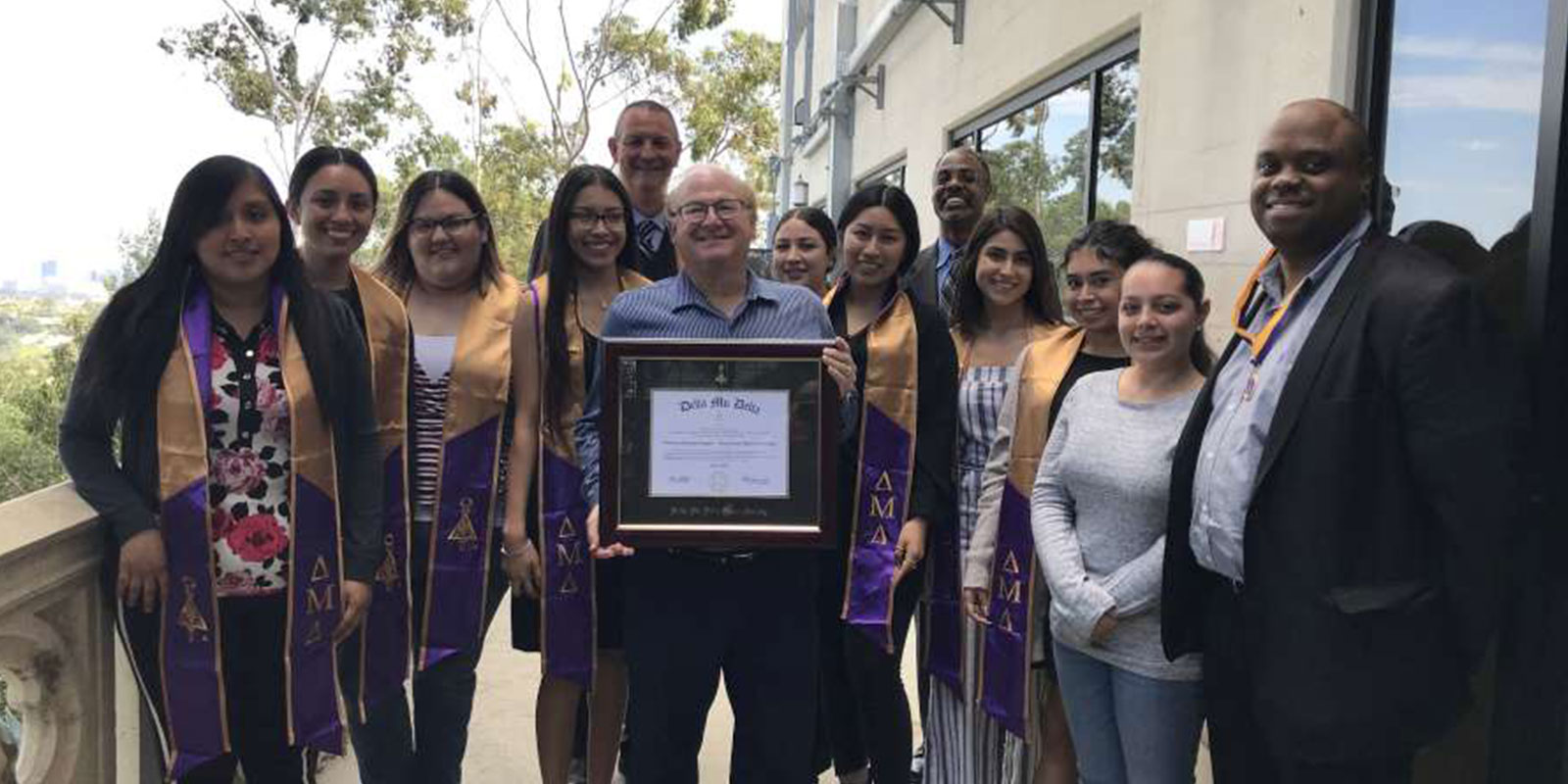 01
01

Our Story
Delta Mu Delta is an international business honor society that recognizes academic distinction of students at select colleges and universities by acknowledging the achievement of its individual members who support and strengthen the communities they serve.
 02
02

Our Motto
Through Knowledge, Power
The Greek letters in the Society’s name stand for
Dia Matheseos Dynamis,
signifying Delta Mu Delta’s motto:
Through Knowledge, Power
the power to manage creatively for social and economic good.
 03
03

Our Mission
Delta Mu Delta is an international business honor society that recognizes academic distinction of students at select colleges and universities by acknowledging the achievement of its individual members who support and strengthen the communities they serve.
Milestones in DMD History
We have come a long way
Society Presidents
Past & Present
2021-Present — Mr. Joel Maier – University of Phoenix
2019-2021 — Kevin J. McCarthy, Ph.D. – Baker University
2017-2019 — Dr. Joni Adkins – Northwest Missouri State University
2015-2017 — Dr. Charles Finn – College of St. Rose
2013-2015 — Dr. Perry Moore – Lipscomb University
2011-2013 — Dr. John Lewington – Maryville University
2009-2011 — Dr. Charles Fazzi – St Vincent College
2007-2009 — Dr. Michael V. LaRocco – University of St. Francis, Illinois
2004-2007 — Dr. Janis Petronis – Tarleton State University, Texas
2001-2004 — Dr. William H. Brunsen – Eastern New Mexico University
1998-2001 — Dr. Randall M. McLeod – Harding University, Arkansas
1995-1998 — Prof. Robert L. McCall – Albany University, Alabama
1994-1995 — Dr. Grace C. Black – Fayetteville State University
1983-1994 — Mr. A.J. Foranoce – New York Institue of Technology
1980-1983 — Dr. James F. Giffin – Eastern Illinois University, Illinois
1966-1980 — Mr. Anthony J Jablonsky – DePaul University, Illinois
1962-1966 — Mrs. Mildred R. Marion – DePaul University, Illinois
1957-1962 — Albert J. Escher – Northwestern University
1957-1957 — Frank A. Neuffer – University of Cincinnati
1954-1957 — Charles J. Kiernan – St. John’s University
1952-1954 — Myron H. Umbreit – Northwestern University
1951-1952 — Professor Peterson – Bucknell University
The DMD Key
What Does the Key Stand For?
 The Delta Mu Delta key is the symbol of our Society most often seen by the world. The key awarded to all new inductees as evidence of their membership. The key has been the society’s symbol from the time of the its founding. It has undergone many changes as the Society has changed. Delta Mu Delta formed to promote higher scholarship in the study of business and to recognize and reward scholastic achievement in those studies. Like Phi Beta Kappa, the honor society to which three of the five founding members belonged, Delta Mu Delta would have a key, a symbol by which members could identify each other and recognized for their achievement. From the first induction in February of 1914, the founding chapter at New York University presented these keys to new members. Although the key does not appear to be required in the early days of the Society, we find in the financial statements of N01ihwestern’s Epsilon Chapter the expenditure for a quantity of keys to match the number of members inducted. These early keys appear to have been meant to hang from a watch chain or something heavier. The key was two sided. Central to the design of the front side was the Greek letters with the year of induction above and the university name below. We have a sample from 1927 on the obverse side the key bore the symbol of a mercantile ship under full sail, representative of commerce in all its dimensions. Curiously, on this older version, there is no English wording “Delta Mu Delta.” As the society began organizing itself around a strong national chapter in the 1950’s, the key became more standardized. A single die was made for the keys, with the suggestion that the name of the university could be engraved on the reverse rather than stamped on the front. This became our Society standard. In ensuing years, the design has been modified so that today the ship and the Greek letters appear on the same side to allow the key to be worn pinned on a lapel or on nickels.
The Delta Mu Delta key is the symbol of our Society most often seen by the world. The key awarded to all new inductees as evidence of their membership. The key has been the society’s symbol from the time of the its founding. It has undergone many changes as the Society has changed. Delta Mu Delta formed to promote higher scholarship in the study of business and to recognize and reward scholastic achievement in those studies. Like Phi Beta Kappa, the honor society to which three of the five founding members belonged, Delta Mu Delta would have a key, a symbol by which members could identify each other and recognized for their achievement. From the first induction in February of 1914, the founding chapter at New York University presented these keys to new members. Although the key does not appear to be required in the early days of the Society, we find in the financial statements of N01ihwestern’s Epsilon Chapter the expenditure for a quantity of keys to match the number of members inducted. These early keys appear to have been meant to hang from a watch chain or something heavier. The key was two sided. Central to the design of the front side was the Greek letters with the year of induction above and the university name below. We have a sample from 1927 on the obverse side the key bore the symbol of a mercantile ship under full sail, representative of commerce in all its dimensions. Curiously, on this older version, there is no English wording “Delta Mu Delta.” As the society began organizing itself around a strong national chapter in the 1950’s, the key became more standardized. A single die was made for the keys, with the suggestion that the name of the university could be engraved on the reverse rather than stamped on the front. This became our Society standard. In ensuing years, the design has been modified so that today the ship and the Greek letters appear on the same side to allow the key to be worn pinned on a lapel or on nickels.
